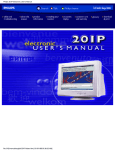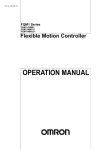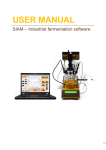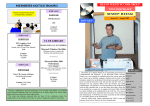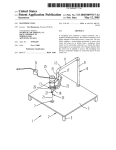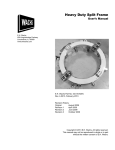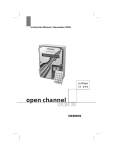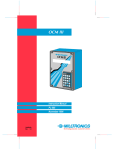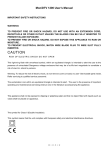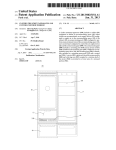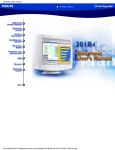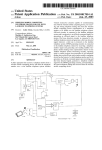Download Monitor adjustment control
Transcript
US006169535B1 (12) United States Patent (10) Patent N0.: (45) Date of Patent: Lee (54) MONITOR ADJUSTMENT CONTROL US 6,169,535 B1 *J an. 2, 2001 OTHER PUBLICATIONS (75) Inventor: Charles Lee, Simi Valley, CA (US) Print out of Graphical User Interface of “Display Manager” Computer Access Technology Corp., Santa Clara, CA, 1997. (73) Assignee: Toshiba America Information Systems, Inc., Irvine, CA (US) Print out of Graphical User Interface of “CustoMaX” Philips Electronics NV. (1994). * ( ) ' - Nonce' This patent issued on a continued pros ecution application ?led under 37 CFR 1.53(d), and is subject to the tWenty year patent term provisions of 35 U.S.C. Print out of Graphical User Interface of, and User’s Manual for, “Monitor Soft Control” Multivideo Labs, Inc., Princ eton, NJ. 154(a)(2). Primary Examiner—Kent Chang Under 35 U.S.C. 154(b), the term of this patent shall be extended for 0 days. (74) Attorney, Agent, or Firm—Pillsbury Madison & Sutro LLP (57) ABSTRACT (21) Appl. No.: 08/902,240 The described embodiments are directed to a method and (22) Filed: apparatus for adjusting a display through user inputs from a graphical user interface. In particular, the described embodi Jul. 29, 1997 ments are directed to such a graphical user interface includ Related US. Application Data (60) Provisional application No. 60/051,288, ?led on Jun. 30, 1997. ing a display Which illuminates a ?gure representative of the cumulative adjustments made to the display. A computer system including a video monitor having a CRT and display (51) Int. Cl.7 ..................................................... .. G09G 5/08 (52) (58) US. Cl. ......................... .. 345/145; 345/127; 345/204 Field of Search ................................... .. 345/204, 145, display illuminated by the CRT. The computer system 345/146, 156, 157, 121, 127, 904, 123, includes a host processor Which is capable of transmitting 342 control circuitry disposed therein. The control circuitry is capable of maintaining at least one adjustment state of a display adjustment signals to the control circuitry to change the at least one adjustment state. Upon a user selection, the (56) References Cited U.S. PATENT DOCUMENTS 4,991,023 5,270,821 5,448,697 2/1991 Nicols . 12/1993 Samuels . 9/1995 Parks et al. . 5,477,241 5,481,276 12/1995 Higgins et al. . 1/1996 Dickey et al. . 5,483,260 1/1996 Parks et al. . 5,499,040 3/1996 McLaughlin et al. . 5,550,556 5,565,897 8/1996 Wu et al. . 10/1996 Kikinis et al. . 5,570,108 10/1996 McLaughlin et al. . display of the CRT illuminates an adjustment display includ ing a single graphical image Which is representative of the cumulative adjustments made to the display. A pointer alloWs a user to move a cursor in the adjustment display to click on and drag edges of the single graphical image to effectuate adjustments to the display. The host processor executes control routines to initiate the transmission of adjustment signals to the control circuitry to change the at least one adjustment state in response to user provided pointer movements for dragging edges of the single graphi cal image. 13 Claims, 4 Drawing Sheets U.S. Patent Jan. 2, 2001 Sheet 2 014 US 6,169,535 B1 109 . ........... s 108 101 107 @5129 102 114 105 @115 . . . . . . ... \ 114. 104 .............. nimkiban. 128 130 / 131 d U.S. Patent Jan. 2, 2001 Sheet 3 of4 US 6,169,535 B1 U.S. Patent Jan. 2, 2001 Sheet 4 of4 US 6,169,535 B1 US 6,169,535 B1 1 2 MONITOR ADJUSTMENT CONTROL acteristics. The control circuitry typically includes control parameters Which have an initial state Which is adjustable in response to signals from the host. Each monitor in a line of monitors typically includes control circuitry from the same manufacturer having control parameters at the same initial This application claims the bene?t of US. Provisional Application No. 60/051,288, ?led Jun. 30, 1997. BACKGROUND OF THE INVENTION state. The control circuitry integrated into each monitor is 1. Field of the Invention then typically adjusted by the same degree to properly adjust The described embodiments are directed to a method and the monitor to a predetermined state at the factory. For monitors having been shipped from the factory, the current GUI based systems, shoWing only the adjustments made in apparatus for adjusting a display through user inputs from a graphical user interface. In particular, the described embodi a current adjustment session, do not easily alloW a technician ments are directed to such a graphical user interface includ ing a display Which illuminates a ?gure for making adjust to readjust such a monitor to its original factory adjustment ments made to the display. 2. Related Art state. Conventional computer monitors typically have built-in control inputs for things such as brightness, contrast, picture position, and siZing. These control inputs as described above SUMMARY OF THE INVENTION 15 An obj ect of an embodiment of the present invention is to provide a method and apparatus for adjusting a display through a graphical user interface. Another object of an embodiment of the present invention require the user to reach to the monitor, sometimes to different locations around the case, to ?nd the proper control. adjustable attribute. Additionally, a neW monitor installed in is to provide a simpli?ed method and apparatus for adjusting a display to initial factory adjustment values. Another object of an embodiment of the present invention a computer system typically requires adjustment of the is to provide a graphical image illuminated on a display Moreover, the control inputs do not necessarily shoW the adjustment limits or the present position of the particular monitor controls. When a neW monitor is installed, it is not 25 Which represents the cumulative adjustments made to the display. unusual for the initial display on the monitor to be off-center, skeWed, and the like. Thus, the set-up procedures must provide for adjustments to the monitor so that the picture Another object of an embodiment of the present invention is to provide a single graphical image illuminated on a may be properly adjusted initially. display having a siZe, shape and orientation Which is rep resentative of the cumulative adjustments made to the dis A computer system typically includes a host computer coupled to a monitor. NeWer computer systems permit the user to make inputs to the host unit of the computer through peripheral devices such as a keyboard or pointing device (such as a mouse) to make adjustments to the monitor. In response to these user inputs, the host computer may trans play. Brie?y, an embodiment of the present invention is directed to a computer system including a video monitor 35 mit adjustment control signals interleaved With video signals to control circuitry in the monitor. Thus, the need for external control inputs on the monitor is eliminated. Some systems, supported by WindoWs or a Macintosh having a CRT and display control circuitry disposed therein. The control circuitry is capable of maintaining at least one adjustment state of a display illuminated by the CRT. The computer system includes a host processor Which is capable of transmitting display adjustment signals to the control circuitry to change the at least one adjustment state. Upon a user selection, the display of the CRT illuminates an adjust operating system, provide graphical user interfaces (GUIs) Which has someWhat simpli?ed the inputting of adjustment ment display including a single graphical image Which is information through a pointer controlled cursor. The “Cus representative of the cumulative adjustments made to the toMaX” system sold by Philips Electronics displays several display. A pointer alloWs a user to move a cursor in the cursor selectable buttons for receiving adjustment informa tion. The “Display Manager” system sold by Computer 45 host processor eXecutes control routines to initiate the trans Access Technology Corp. displays a draggable lever for inputting adjustments for a selected characteristic. A graphi cal shape represents the adjustments to the display made mission of adjustment signals to the control circuitry to change the at least one adjustment state in response to user provided pointer movements for dragging edges of the during a current adjustment session for the selected charac teristic. The “Monitor Soft Control” system sold by Multi Video Labs, Inc. generates a separate selectable display for single graphical image. By using a single graphical image for receiving user inputs to adjust multiple characteristics of the display, and representing the cumulative adjustments in the multiple characteristics by the siZe, shape and orientation of the receiving inputs for each display characteristic. Each select able display includes its oWn draggable lever for receiving adjustment inputs for the selected characteristic and its oWn gauge for shoWing the adjustments made during the current adjustment session. US. Pat. No. 5,565,897 assigned to EloneX Technologies, Inc. describes multiple shapes Which 55 the cumulative adjustments made. Thus, a technician can easily adjust a display according to its initial factory adjust ment states as represented by the graphical image. multiple shapes to initiate the transmission of display adjust ment signals. When the multiple shapes are not rectangular, BRIEF DESCRIPTION OF THE FIGURES the user may click on and drag portions of the multiple ing input adjustments are complex and employ multiple images to correspond With different adjustable display char graphical image, the described embodiments provide a con sistent procedure for making the adjustments and recording are calibrated to appear rectangular on a properly adjusted monitor. The user may click on and drag portions of the shapes until they are rectangular, thus putting the monitor in its properly adjusted state. The current GUI based systems for receiving and display adjustment display to click on and drag edges of the single graphical image to effectuate adjustments to the display. The 65 FIG. 1 shoWs a block diagram of a host computer system connected to a CRT monitor, including remote control of display functions according to an embodiment of the present invention. FIG. 2 shoWs a graphical image illuminated on a display Which has a siZe, shape, and orientation Which is represen US 6,169,535 B1 3 4 tative of the cumulative adjustments made to the display according to the embodiment of FIG. 1. executing logic, and performing computations; a memory 17, typically a random access memory (RAM) and hard disk for storing control routines and data; a basic input/output system (BIOS) 19; a keyboard controller 21 coupled to a keyboard 23; and a pointer port 25 coupled to a pointer device 27, Which may be a track ball, mouse, pen digitiZer, or other types of pointer devices capable of moving a cursor FIGS. 3a, 3b and 3c illustrate hoW a user adjusts the siZe of the display through the graphical image illuminated thereon, and hoW the graphical image represents such cumu lative siZe adjustments. FIG. 4 illustrates hoW a user adjusts the location of the illuminated in the monitor 13. The elements described above display through the graphical image illuminated thereon, are bus connected by one or more bus structures represented and hoW the graphical image represents such cumulative location adjustments. 10 FIG. 5 illustrates hoW a user adjusts the rotational orien It is Well knoWn in the art that there are many variations tation of the display through the graphical image illuminated thereon, and hoW the graphical image represents such cumu lative rotational adjustments. 15 FIG. 6 illustrates hoW a user adjusts the horiZontal boWing or pincushion effects of the display through the graphical image illuminated thereon, and hoW the graphical image represents such cumulative horiZontal boWing adjustments. in the architecture shoWn for the host computer system of FIG. 1 and the architecture is meant to be representative of conventional architecture in general. There are, similarly, many alternatives for the particular functional elements shoWn. For example, FIG. 1 illustrates a keyboard 23 as an input device. There are alternatives for input devices, such as touch screens, pen pads, and the like, and such alterna FIG. 7 illustrates hoW a user adjusts the horiZontal sym tives may be used in other embodiments of the invention. There are similarly several alternatives for pointer devices in metry effects of the display through the graphical image illuminated thereon, and hoW the graphical image represents addition to the ones listed above. such cumulative horiZontal symmetry adjustments. FIG. 8 illustrates hoW a user adjusts the parallelism effects of the display through the graphical image illuminated by interconnecting bus 29 Which also connects to video circuitry 33 through a video BIOS 31. 25 thereon, and hoW the graphical image represents such cumu In the embodiment of FIG. 1, video circuitry is a VGA subsystem 33, Which provides video dot data for a monitor such as R, G, and B signals, 35, 37, and 39, and also horiZontal synchroniZation (HSYNC) signals 41 and vertical synchroniZation (VSYNC) signals 43, to a cable interface lative parallelism adjustments. 45. These signals and ground connections are coupled to the monitor 13 conventionally by a VGA cable 47, Wherein the signals are coupled to separate conductors. According to an embodiment, the host computer 11 may transmit data to adjustment circuitry 52 of the monitor 13 FIG. 9 illustrates hoW a user adjusts the trapeZoidal effects of the display through the graphical image illuminated thereon, and hoW the graphical image represents such cumu lative trapeZoidal adjustments. DETAILED DESCRIPTION through the VGA cable 47 by inserting serial data packets Embodiments of the present invention are directed to a 35 betWeen pulses of the VSYNC signals 43 as described in detail in US. Pat. No. 5,565,897 assigned to Elonex Technologies, Inc. at Col. 4, line 23 through Col. 7, line 8. In another embodiment, the host computer 11 may transmit method and apparatus for interactively adjusting an elec tronic display Which is adjustable for the effects of rotation, siZe, parallelism, centering, trapeZoidism, boWing, and sym metry. The display portion shoWs a single graphical image, control signals to the adjustment circuitry 52 by using a code to modulate the pulse Width of the VSYNC pulse as described in detail in US. Pat. No. 5,550,556 assigned to Which provides a graphical gauge, and a cursor Which is movable in response to pointer movements. The single graphical image includes edges Which are draggable in response to cursor movements to receive inputs to adjust the display. The siZe, position, shape and orientation of the single graphical image preferably re?ect the cumulative adjustments made to the display. 45 The DDC line 38 also enables bidirectional communication With the monitor 13. Thus, the monitor 13 may transmit signals to the host computer 11 to inform the host computer 11 of the current adjustment state of the monitor 13. The present invention is not limited to systems Which transmit signals to the monitor 13 using these techniques as there are several conventional Ways to transmit such information. The adjustment circuitry 52 may include a MultiVideo An embodiment of the present invention includes a com puter system With a monitor having a cathode ray tube (CRT) disposed therein and a host unit coupled to the monitor. The monitor includes control circuitry With several alterable parameters Which de?ne one or more adjustment characteristics directed to display rotation, siZe, parallelism, centering, trapeZoidism, boWing, or symmetry. The host unit preferably includes, or is coupled to, a pointing device (such as a mouse, track ball, joy stick, or pen digitiZer, etc.) for MultiVideo Labs, Inc. at Col. 2, line 50 through Col. 15, line 17. In another embodiment, the VGA subsystem 33 provides a Display Data Channel (DDC) line 38 to the interface 45, alloWing the transmission of signals to the adjustment cir cuitry 52 independent of the transmission of video signals. 55 Labs, Inc., chipset model number 82C610 Which is bundled With appropriate control softWare to be loaded in the controlling the movement of a cursor illuminated in the display. A real time display illuminated in the CRT and memory 17 and executed on the CPU 15. This control softWare routines executing on a CPU of the host unit used softWare facilitates the transmission of control signals from the host computer 11 to the adjustment circuitry 52 in the in conjunction With the pointing device provide a graphical user interface (GUI) permitting the user to make inputs to monitor 13 by encoding the adjustment signals in the signals the host unit by clicking on and dragging features of the Which transmit video dot data. According to an embodiment of the present invention, the illuminated display. FIG. 1 is a simpli?ed block diagram of a host computer 11 connected to a CRT-type monitor 13, providing remote control of display functions on the monitor 13 according to an embodiment of the present invention. The host computer 11 comprises a CPU 15 for managing computer functions, user may provide adjustment inputs to the adjustment cir cuitry 52 from a GUI provided by the pointer device 27 used 65 in conjunction With a single graphical image 100 displayed on the monitor 13, providing a graphical gauge as shoWn in FIG. 2. This GUI may be provided by softWare Written for US 6,169,535 B1 5 6 a Windows or Macintosh operating system, or some other ?rst mode, pointer movements can only initiate adjustments for the selected adjustment characteristic. In the second mode, adjustments can be made for different adjustment operating system supporting programs Which generate dis plays With cursor selectable icons for receiving user inputs. For the WindoWs embodiments, the softWare is preferably characteristics by moving the cursor to a designated spot or activation region. The user may then click on the spot or click on and drag the spot to make the selected adjustment Written in Visual C and has an interface With the control softWare bundled With the adjustment circuitry 52 to permit While the corresponding visual characteristic of the graphi the user to provide inputs to the routines of the control softWare via the GUI. The user may initiate a signal from the host to the CRT monitor to change the screen control parameters to thereby adjust the display siZe, position, rotation, horiZontal boWing, symmetry, parallelism, or trap cal image 100 changes accordingly. 10 eZoidal effects as discussed beloW in conjunction With FIGS. 3a through 9. adjustment. The graphical image 100 is a single shape in a device 27 in the ?rst mode. FIG. 3c illustrates the siZe adjustment as selected by moving the cursor to a particular region of the rectangular region 109 in the second mode, FIG. 2 shoWs a graphical image 100 for the CRT monitor rectangular region 109. The graphical image 100 is prefer FIGS. 3a and 3b illustrate the siZe adjustment Which folloWs selection of the appropriate icon With the pointer 15 causing the cursor to change its shape and/or color to indicate that a siZe adjustment has been selected. Unlike in FIG. 2, FIGS. 3a, 3b and 3c shoW the graphical image 100 as being rectangular and upright (i.e., the top segment 131 and bottom segment are horiZontal) in the rectangular region 109, indicating that no adjustments have been made to adjust ably a solid image or a simple closed curve. The graphical image 100 includes a left edge 114 and a right edge 115 having a set of points 101 through 108 Which the user may rotation, symmetry, boWing, parallelism or trapeZoidism. click on and drag to provide the desired adjustment inputs. The rectangular region 109 may be located anyWhere on the The resulting siZe of the display is de?ned by a Width and a height. The dotted rectangles 129 and 128 de?ne the mini mum and maXimum limits for siZe adjustment, respectively. Thus, the Width and height of the rectangles 128 and 129 preferably correspond With eXtreme siZe adjustment limits of screen and preferably has dimensions proportional to those of the screen siZe. The rectangular region 109 may be as large as the screen and is preferably at least as large as one seventh the screen in either dimension to alloW reasonable 25 the adjustment circuitry 52. These rectangles 128 and 129, movement for the graphical image 100. and the graphical image 100 are preferably concentric. The length of the bottom segment 111 represents the cumulative Width adjustment of the display. The perpendicular distance betWeen the top segment 131 and the bottom segment 111 represents the cumulative height adjustment to the display. FIGS. 3a and 3b illustrate an adjustment for increasing the The eight points 101 through 108 partition the edges 114 and 115 into thirds, approximately. The user may use the pointer device 27 to individually click on and drag the points 101 through 108 (or the edges as described beloW) to send control signals to the monitor 13 to incrementally adjust the control parameters in the adjustment circuitry 52. The move ment of these points 101 through 108 may change the siZe, position, orientation and shape of the graphical image 100 in the rectangular region 109. The shape of the graphical image 100 is obtained by connecting the points 101 through 108 siZe of the monitor screen. In FIG. 3b, the Width of the display is increased to approach the maXimum Width pro vided by the adjustment circuitry 52. In the ?rst mode, the 35 user may click on and drag point 104 to the right until the right edge 115 meets the right border of the rectangle 128, With segments. A top segment (or edge) 131 (betWeen points or click on and drag point 105 to the left until the left edge 101 and 108) preferably remains parallel to a bottom seg 114 meets the right border the rectangle 128. As the graphi cal image 100 and rectangles 128 and 129 are concentric in ment (or edge) 111 (betWeen points 104 and 105). Thus, the resulting siZe, position, orientation and shape of the image the preferred embodiment, moving the left edge 114 inWard 100 after the adjustments represent the cumulative adjust ments made to the adjustment circuitry 52. The graphical image 100, as depicted in FIG. 2, shoWs that adjustments for position, rotation, boWing (“pincushion”), parallelism and trapeZoidal effects have or outWard causes the right edge 115 to move inWard in a corresponding manner. The user can similarly adjust the height of the display by clicking on and dragging any of the 45 been made. For simplicity in illustrating the individual adjustments for each of these alterable parameters, FIGS. 3a through 9 do not each shoW that cumulative adjustments corner points 101, 104, 105 or 108 to move the top segment 131 and the bottom segment 111 inWard or outWard. Alternatively, in the ?rst mode the user may move the cursor to a spot such as the circle 130 (i.e., a location Which is not on a point or segment of the graphical image 100) and have been made for all of these alterable parameters. HoWever, as Will be explained in greater detail beloW, the then click on the pointer device 27 to move the nearest point user can consistently make adjustments or eXamine cumu cursor at the circle 130 (or as close as possible Within the lative adjustments for any particular alterable parameter independent of any prior adjustment to any other alterable parameter. limits of the rectangle 128), thus enlarging the graphical of the graphical image 100 (point 101 in this case) to the image 100. Similarly, the user may move the cursor to a location Within the graphical image 100 (not shoWn) and In one embodiment, the user may select a particular 55 then click on the pointer device 27 to move the point on the graphical image 100 Which is nearest to the cursor to the location of the cursor (or as close as possible While remain may illuminate a cursor selectable icon for each of siZe, ing outside of the rectangle 129) to shrink the graphical position, rotation, pincushion, symmetry, parallelism, and image 100. Also, the user may move the cursor to a point characteristic to be adjusted by selecting an appropriate icon (not shoWn) in the display in a ?rst mode. Thus, the display trapeZoidal effects. In a second mode, as described in greater detail beloW in connection With FIGS. 3a through 9, the user Which is close to one of the sides of the graphical image (i.e., top segment 131, bottom segment 111, left edge 114 or right edge 115) yet distant from any of the corner points (i.e., points 101, 104, 105 or 108) and click on the pointer device can move the cursor in the display to a particular region to select the desired type of adjustment to be made. The shape and/or color of the cursor then preferably changes to indicate the corresponding selected type of adjustment. Pointer movements from the pointer device 27 are inter preted in a manner consistent With the selected mode. In the 27 to move the side to the cursor (or as close as possible 65 Within the limits of the rectangles 128 and 129). This causes an adjustment in only one siZe dimension (i.e., height or Width) While making no changes to the other siZe dimension. US 6,169,535 B1 7 8 As shown in FIG. 3c, size adjustments in the second mode are made by merely moving the cursor in one of the regions second mode. Unlike in FIG. 2, FIG. 5 shoWs the graphical image 100 as being rectangular in the rectangular region 202 or 204 Which are each located about one of the corner 109, indicating that no adjustments have been made to adjust points 101, 104, 105 or 108. The user moves the cursor to symmetry, boWing, parallelism or trapeZoidism. one of the regions 204 inside of the graphical image 100 to In the ?rst mode, the user may click on and drag any of shrink the siZe of the graphical image or moves the cursor to the points 101 through 108 to rotate the graphical image 100 one of the regions 202 outside of the graphical image 100 to about its center 134 to initiate signals to adjust the rotational enlarge the graphical image 100. The regions 202 are preferably Within the rectangle 128 and the regions 204 are orientation of the display in the parameters of the adjustment circuitry 52. In the second mode, the user may click on and preferably outside of the rectangle 129 to re?ect the limits in the siZe adjustment. When the cursor is in one of the regions 202 or 204, the cursor preferably changes shape and/or color drag the segment connecting points 101 and 102 or the segment connecting points 107 and 108 to rotate the graphi cal image 100 about the center 134. An angle 113 betWeen to indicate to the user that a siZe adjustment is being the bottom segment 111 and the horiZontal aXis 112 repre selected. The user then clicks on the pointer device 27 to sents the cumulative rotational adjustments made to the move the corresponding corner point to the cursor to change 15 adjustment circuitry 52. Such cumulative rotational adjust the siZe of the graphical image 100 and transmit the control ments are preferably limited to ten degrees in the clockWise signal to the monitor 13 to make the corresponding siZe or counter-clockWise directions. adjustment. FIG. 6 illustrates the horiZontal boWing or “pincushion” adjustment Which folloWs the selection of the appropriate icon With the pointer device 27 (?rst mode), or by moving the cursor to the segment connecting points 102 and 103 (second mode), causing the cursor to change its shape and/or color. Unlike in FIG. 2, FIG. 6 shoWs the graphical image 100 as being upright in the rectangular region 109 (i.e., top FIG. 4 illustrates the position adjustment Which folloWs selection of the appropriate icon With the pointer device 27 (?rst mode) or by moving the cursor to be Within a region bordered by a dotted rectangle 132 (second mode). Unlike in FIG. 2, FIG. 4 shoWs the graphical image 100 as being rectangular (indicating that no adjustment has been made for the effects of horiZontal symmetry, horiZontal boWing, par allelism or trapeZoidism) and upright in the rectangular region 109 (i.e., the top segment 131 and bottom segment 25 segment 131 and bottom segment 111 are horiZontal, indi cating that no adjustments have been made for rotational 111 are horiZontal, indicating that no adjustments have been alignment), and having top and bottom segments 131 and 111 having the same length and aligned (indicating that no made to adjust rotation, symmetry, boWing, parallelism or trapeZoidism). Upon selection of this adjustment in the ?rst trapeZoidism). The left edge 114 and the right edge 115 adjustments have been made to correct parallelism or mode, a circle 133 may appear in this region on a perpen curve inWard or outWard together. In the ?rst mode, the user dicular bisector 110 Which is preferably at about the center also appear upon selection of this adjustment. The user may may initiate signals to the adjustment circuitry 52 to adjust the horiZontal boWing effect by either clicking on and dragging points 102 or 103 (or the segment connecting these adjust the position of the display by clicking on and dragging points) to move the right edge 115, or clicking on and of the graphical image 100. The dotted rectangle 132 may a spot Within the restricted region bordered by the dotted rectangle 132. Alternatively, the user may click on and drag dragging points 106 or 107 (or the segment connecting these points) to move the left edge 114. As a result, the left edge 114 and the right edge 115 curve toWard or aWay from each other to represent the horiZontal boWing adjustment While the circle to a desired location Within the dotted rectangle 132. points 101, 104, 105, and 108 remain stationary. In the In the second mode, the user selects the position adjust ment by merely moving the cursor to a location Within the dotted rectangle 132 to cause the circle 133 to appear and the color and/or shape of the cursor to change to indicate second mode, the user clicks on and drags the segment connecting points 102 and 103 to move the edges 114 and 115 to curve inWard or outWard together. selection of the position adjustment. The dotted rectangle The dotted lines shoW the alloWable eXtent for the shift if 132 may also appear in response to moving the cursor to this 45 the user is clicking on and dragging the left edge 114 to make region. The user then clicks on the pointer device 27 to cause the adjustment. The eXtent of the boWing in the left edge 114 the circle 133 to move to the location of the cursor, thus is centered about the reference edge 116 betWeen points 105 shifting the entire graphical image 100 by a corresponding and 108. The deviation of the left edge 114 from the amount to indicate the changes in the adjustment of the monitor 13. The dotted rectangle 132 preferably re?ects a restricted reference edge 116, in conjunction With the deviation of the right edge 115 from a corresponding reference edge (not shoWn), represents the cumulative adjustment as discussed in greater detail beloW. In another embodiment (not shoWn), additional points are disposed on the top and bottom edges region Which limits the movement of the graphical image 100 to about ten percent of the rectangular region 109 to prevent the movement of the graphical image 100 off of the rectangular region 109. Thus, the position of the circle 133 represents cumulative position adjustment. As shoWn in 111 and 131 to permit the user to make similar adjustments 55 FIG. 4, the circle 133 has been moved to center the display close to the top and left so as to set the corresponding parameters of the adjustment circuitry 52 close to their limits. FIG. 5 illustrates the rotation adjustment Which folloWs the selection of the appropriate icon With the pointer device 27 (?rst mode), or by moving the cursor to the segment connecting points 101 and 102 or the segment connecting points 107 and 108 (second mode), causing the cursor to change its shape and/or color. Of course, other segments may be chosen to initiate the rotational adjustment in the for boWing in the vertical direction by clicking on and dragging the top edge 131 or the bottom edge 111. FIG. 7 illustrates the horiZontal symmetry adjustment Which folloWs the selection of the appropriate icon With the pointer device 27 (?rst mode), or by moving the cursor to the segment connecting points 106 and 107 (second mode), causing the cursor to change its shape and/or color. Unlike in FIG. 2, FIG. 7 shoWs the graphical image 100 as being 65 upright in the rectangular region 109 (indicating that no adjustments have been made for rotational alignment), and having top and bottom segments 131 and 111 having the same length and aligned (indicating that no adjustments have been made to correct parallelism or trapeZoidism). The US 6,169,535 B1 9 10 left edge 114 and the right edge 115 move together to the left or the right. In the ?rst mode, the user may initiate signals to the adjustment circuitry 52 to adjust the horizontal sponding to the rightWard deviation of the left edge 114, indicating a corresponding cumulative adjustment for hori Zontal symmetry. Subtracting these values provides a result symmetry effect by either clicking on and dragging points equal to Zero, indicating no cumulative adjustment for 102 or 103 (or the segment connecting these points) to move horiZontal boWing. the right edge 115, or clicking on and dragging points 106 FIG. 8 illustrates the parallelism adjustment Which fol loWs the selection of the appropriate icon With the pointer device 27 (?rst mode), or by moving the cursor to about the or 107 (or the segment connecting these points) to move the left edge 114. In the second mode, the user clicks on and drags the segment connecting points 107 and 108 to cause the edges 114 and 115 to curve to the left or right together While points 101, 104, 105, and 108 remain stationary. As a middle of the top segment 131 (second mode), causing the cursor to change its color and/or shape to indicate selection result, the left edge 114 and the right edge 115 move together to the left or right to represent the horiZontal symmetry adjustment. The dotted lines shoW the alloWable eXtent for the shift if the user is moving the left edge 114 to make the adjustment. The eXtent of the boWing in the left edge 114 is centered about the reference segment 116 betWeen points 105 and 108. The deviation of the left edge 114 from the reference 15 no adjustments have been made to correct trapeZoidism), and having straight left and right segments 114 and 115 segment 116, in conjunction With the deviation of the right edge 115 from its corresponding reference edge, represents the cumulative adjustment as discussed in greater detail beloW. In another embodiment (not shoWn), additional points are disposed on the top and bottom segments 111 and 131 to permit the user to make similar adjustments for symmetry in the vertical direction by clicking on and dragging the top segment 131 or the bottom segment 111. 25 In both the horiZontal boWing and symmetry adjustments illustrated in FIGS. 6 and 7, the left segment 114 and right segment 115 preferably have an adjustment range Which is about 30% of the difference betWeen the maXimum and 111. The limits for the tilt are preferably about ?fteen degrees in a clockWise or counter-clockWise direction. alloWs an inWard or outWard deviation of the left segment 114 from the reference segment 116 of about 15% of this difference. As discussed above, both symmetry and boWing adjustments affect the curvature of the edges 114 and 115. The shapes of these edges preferably represent the combined effect of the cumulative symmetry and boWing adjustments. By noting the leftWard or rightWard deviations of each of the left edge 114 and the right edge 115 from respective refer ence segments (the reference segment corresponding to the left edge 114 is reference segment 116 and the reference segment corresponding to the right edge 115 is not shoWn), the cumulative adjustment effect solely due to horiZontal 35 symmetry adjustments is represented as half the sum of the deviations. The effect solely due to horiZontal boWing adjustments is represented as half of the difference betWeen the leftWard or rightWard deviations of the left edge 114 and the deviations of the right edge 115. FIG. 6, for example, shoWs that the left edge 114 and the right edge 115 are curved outWard by the same amount. Adding a value corresponding to the leftWard deviation the left edge 114 (arbitrarily a positive value) to a value corre sponding to the rightWard deviation of the right edge 115 (correspondingly a negative value having a magnitude equaling the value associated With the leftWard deviation of the left edge 114) results in Zero, indicating no cumulative adjustment for horiZontal symmetry. Subtracting these val ues provides a result equal to double the value representing the leftWard deviation of the left edge 114, indicating a 45 FIG. 9 illustrates the trapeZoidal adjustment Which fol loWs the selection of the appropriate icon With the pointer device 27 (?rst mode), or by moving the cursor to a leftmost or rightmost portion of the top segment 131 (second mode), causing the cursor to change its color and/or shape to indicate selection of the trapeZoidal adjustment. Unlike in FIG. 2, FIG. 9 shoWs the graphical image 100 as upright in the rectangular region 109 (i.e., having top and bottom segments 131 and 111 Which are horiZontal in the rectan gular region 109, indicating that no adjustments have been made for rotational alignment), having left and right edges 114 and 115 Which are straight (indicating that no adjust ments have been made for horiZontal boWing or symmetry), and having the bottom segment 111 centered Within the top segment 131 (indicating that no adjustments have been made to correct parallelism). In the ?rst mode, the user may initiate the transmission of trapeZoidal adjustment signals to the adjustment circuitry 52 55 by clicking on and dragging either point 101 or 108 to stretch or compress the top segment 131 horiZontally. The points 101 and 108 move inWard and outWard together to shorten or lengthen the top segment 131 While points 104 and 105 remain stationary. In the second mode, the user may click on and drag the aforementioned leftmost or rightmost portion of the top segment 131 to move the points 101 and 108 inWard and outWard together to shorten or lengthen the top segment 131 While points 104 and 105 remain stationary. The cumulative adjustment is represented by the ratio of the difference 121 betWeen the length of the top segment 131 corresponding cumulative adjustment for horiZontal boWing effects. FIG. 7, on the other hand, shoWs that the left edge 114 and the right edge 115 are each curved to the right by the same edge 115 provides a value equal to double the value corre (indicating that no adjustments have been made for hori Zontal symmetry or boWing). In the ?rst mode, the user may initiate parallelism adjust ment signals to the adjustment circuitry 52 by clicking on and dragging either point 101 or point 108 to shift the top segment 131 in a direction substantially parallel to the bottom segment 111 While the bottom segment 111 remains stationary. In the second mode, the user clicks on the pointer device 27 at about the middle of the top segment 131 and drags the top segment 131 to the left or right While the bottom segment 111 remains stationary. The cumulative adjustment is represented by the angle 117 betWeen the vertical aXis 118 and the line passing through the midpoints 119 and 120 of the top segment 131 and the bottom segment minimum Widths for siZe adjustment (FIGS. 3a and 3b). This amount. Thus, adding the values corresponding to each of the rightWard deviations of the left edge 114 and the right of the parallelism adjustment. Unlike in FIG. 2, FIG. 8 shoWs the graphical image 100 as being upright in the rectangular region 109 (indicating that no adjustments have been made for rotational alignment), having top and bottom segments 131 and 111 With the same length (indicating that and the length of the bottom segment 111 to the maXimum height. The maXimum height is preferably the length of the 65 vertical dimension of the dotted rectangle 128, Which is the larger of tWo rectangles used in limiting the siZe adjustment (FIGS. 3a and 3b). US 6,169,535 B1 11 12 When adjustments are complete, the user may “save” the logic for detecting selection of the pointer device While adjustments before exiting the adjustment program by the cursor is at a location in the region associated With selecting an icon (not shoWn) to command the host unit to record the adjusted setting of the screen control parameters the selected adjustment characteristic; logic for adjusting the display system according to the in an “INI” ?le Which is stored in the memory 17 or the hard selected adjustment characteristic in response to a disk of the host computer 11. Thus, each “saved” adjustment selection of the pointer device; and logic for expanding or contracting the image in response causes a change in the INI ?le and a related change in the to detecting a selection of the pointer device While the cursor is stationary at a location separated from the shape of the image 100 displayed on the CRT 53. The user may also choose not to save the adjustments through a different command to the host unit. This command initiates a resetting of the screen control parameters in the controller 10 image meets the cursor to indicate a change in the state chipset to their values prior to the adjustments made during the current adjustment session. This is performed by sending a signal from the host computer 11 to the monitor 13 to reset the control parameters to the values stored in the INI ?le, image and in a region associated With an adjustment characteristic for siZe such that the perimeter of the 15 re?ecting the cumulative adjustments made prior to the current session. of the adjustment characteristic for siZe. 2. The display system of claim 1, Wherein the plurality of adjustment characteristics includes at least one of rotation, siZe, parallelism, centering, trapeZoidism, boWing and sym metry. 3. The display system of claim 1, Wherein the display In the embodiment in Which the VGA subsystem 33 system further includes a cathode ray tube responsive to transmits adjustment control signals via the DDC line 38, the video signals. bidirectional communication of the DDC line 38 may pro vide for automatic adjustments. The DDC line 38 may periodically transmit back the state of the adjustment screen control parameters to the host computer 11 to update the INI ?le. Alternatively, the DDC line 38 may transmit the state of tube is disposed Within a video monitor Which receives adjustment signals from a host processor to change selected ones of the plurality of adjustment states. 5. A computer readable medium for use in conjunction the adjustment screen control parameters upon any changes. The visual characteristics of the graphical image 100 may then change in response to re?ect the changes in the adjust 4. The display system of claim 3, Wherein the cathode ray 25 With circuitry for adjusting a display system having an adjustment state for each of a plurality of adjustment characteristics, at least one of the adjustment characteristics ment state. being an adjustment characteristic for siZe, the computer readable medium having computer readable instructions As discussed above, FIGS. 3a through 9 illustrate hoW a technician can easily adjust a display according to its initial orientation of the graphical image 100 so that it represents encoded thereon for: placing an image on a display having visual characteris tics Which are representative of the adjustment state for these initial factory adjustment values. Representing the cumulative adjustments to the display by the siZe, shape, at least one of the adjustment characteristics, the image having a perimeter; factory adjustment values by changing the siZe, shape, and orientation, and location With a single graphical image also 35 simpli?es adjustment procedures. detecting When a cursor is moved to a region in the display associated With a selected one of the adjustment While the description above refers to particular embodi ments of the present invention, it Will be understood that many modi?cations may be made Without departing from the spirit thereof. The accompanying claims are intended to detecting a selection of the pointer device While the cursor is at a location in the region associated With the selected cover such modi?cations as Would fall Within the true scope adjusting the display system according to the selected characteristics; adjustment characteristic; and spirit of the present invention. The presently disclosed embodiments are therefore to be considered in all respects as illustrative and not restrictive, the scope of the invention being indicated by the appended claims, rather than the foregoing description, and all changes adjustment characteristic in response to a selection of the pointer device, and 45 Which come Within the meaning and range of equivalency of a region associated With an adjustment characteristic the claims are therefore intended to be embraced therein. for siZe such that the perimeter of the image meets the What is claimed is: cursor to indicate a change in the state of the adjustment characteristic for siZe. 6. The computer readable medium of claim 5, the com 1. Adisplay system having an adjustment state for each of a plurality of adjustment characteristics, at least one of the adjustment characteristics being an adjustment characteristic for siZe, the display system comprising: an image in a display having visual characteristics Which are representative of the adjustment state for at least one of the adjustment characteristics, the image having a perimeter; a plurality of regions in the display associated With the image, each of the regions corresponding to one of the adjustment states; eXpanding or contracting the image in response to detect ing a selection of the pointer device While the cursor is stationary at a location separated from the image and in 55 puter readable medium further including computer readable instructions encoded thereon for adjusting the display for at least one of rotation, siZe, parallelism, centering, trapeZoidism, boWing and symmetry adjustment character istics. 7. The computer readable medium of claim 5, the com puter readable medium further including computer readable instructions encoded thereon for initiating a transmission of video signals to a cathode ray tube. movements from a pointer device, the cursor having 8. A method of adjusting a display system having an adjustment state for each of a plurality of adjustment visual image; characteristics, the method comprising: a cursor Which is movable in the display in response to logic for detecting When the cursor is moved to a region in the display associated With a selected one of the adjustment characteristics; placing an image on the display having visual character istics Which are representative of the adjustment state for at least one of the adjustment characteristics; US 6,169,535 B1 14 13 encoded thereon for initiating a transmission of video sig detecting When a cursor is moved to a region in the display associated With a selected one of the adjustment nals to a cathode ray tube. characteristics; 11. The display system of claim 1, the display system further comprising logic for affecting the visual appearance detecting a selection of the pointer device While the cursor is at a location in the region associated With the selected of the cursor upon detection that the cursor is in a region adjustment characteristic; corresponding With a selected adjustment characteristic, the visual appearance being affected to indicate the selected adjusting the display system according to the selected adjustment characteristic. adjustment characteristic in response to a selection of the pointer device; and eXpanding or contracting the image in response to detect ing a selection of the pointer device While the cursor is stationary at a location separated from the image and in 12. The computer readable medium of claim 5, the 10 readable instructions encoded thereon for affecting a visual appearance of the cursor upon detection that the cursor is in a region associated With an adjustment characteristic for siZe such that the perimeter of the image meets the cursor to indicate a change in the state of the adjustment characteristic for siZe. 9. The method of claim 8, the method further including adjusting the display for at least one of rotation, siZe, computer readable medium further comprising computer 15 a region corresponding With a selected adjustment characteristic, the visual appearance being affected to indi cate the selected adjustment characteristic. 13. The method of claim 8, the method further comprising affecting a visual appearance of the cursor upon detection that the cursor is in a region corresponding With a selected parallelism, centering, trapeZoidism, boWing and symmetry adjustment characteristic, the visual appearance being adjustment characteristics. affected to indicate the selected adjustment characteristic. 10. The method of claim 8, the computer readable medium further including computer readable instructions * * * * *















